Which of the following statements is consistent with the principle of competitive exclusion?
- A) Bird species generally do not compete for nesting sites.
- B) The random distribution of one competing species will have a positive impact on the population growth of the other competing species.
- C) Two species with the same fundamental niche will exclude all other competing species.
- D) Even a slight reproductive advantage will eventually lead to the elimination of the less well adapted of two competing species.
D
According to the competitive exclusion principle, two species cannot continue to occupy the same
- A) habitat.
- B) niche.
- C) territory.
- D) range.
- E) biome.
B
Which of the following best describes resource partitioning?
- A) competitive exclusion that results in the success of the superior species
- B) slight variations in a species' niche that allow similar species to coexist
- C) two species that can coevolve to share identical niches
- D) differential resource utilization that results in a decrease in community species diversity
- E) a climax community that is reached when no new niches are available
B
As you study two closely related predatory insect species, the two-spot and the three-spot
avenger beetles, you notice that each species seeks prey at dawn in areas without the other species. However, where their ranges overlap, the two-spot avenger beetle hunts at night and the three-spot hunts in the morning. When you bring them into the laboratory and isolate the two different species, you discover that the offspring of both species are nocturnal. You have discovered an example of
- A) mutualism.
- B) Batesian mimicry.
- C) commensalism.
- D) resource partitioning.
D
Resource partitioning would be most likely to occur between
- A) sympatric populations of a predator and its prey.
- B) sympatric populations of species with similar ecological niches.
- C) sympatric populations of a flowering plant and its specialized insect pollinator.
- D) allopatric populations of the same animal species.
- E) allopatric populations of species with similar ecological niches.
B
Which of the following is an example of cryptic coloration?
- A) highly contrasting bands on a coral snake
- B) brown or gray color of tree bark
- C) bright markings of a viceroy butterfly's wings
- D) orange or yellow colors of an insect-pollinated flower's petals
- E) a walking stick, which is an insect that resembles a twig
E
Which of the following is an example of Batesian mimicry?
- A) an insect that resembles a twig
- B) a butterfly that resembles a leaf
- C) a nonvenomous snake that looks like a venomous snake
- D) a fawn with fur coloring that camouflages it in the forest environment
- E) a snapping turtle that uses its tongue to mimic a worm, thus attracting fish
C
Which of the following is an example of aposematic coloration?
- A) the brightly colored patterns of poison dart frogs
- B) eye color in humans
- C) green color of a plant
- D) colors of an insect-pollinated flower
- E) a katydid whose wings look like a dead leaf
A
Dwarf mistletoes are flowering plants that grow on certain forest trees. They obtain nutrients and water from the vascular tissues of the trees. The trees derive no known benefits from the dwarf mistletoes and can be harmed if nutrients and water are scarce in the environment. Which of the following best describes the interactions between dwarf mistletoes and trees?
- A) mutualism
- B) parasitism
- C) commensalism
- D) facilitation
- E) competition
B
Evidence shows that some grasses benefit from being grazed. Which of the following terms would best describe this plant-herbivore interaction?
- A) mutualism
- B) commensalism
- C) parasitism
- D) competition
- E) predation
A
White-breasted nuthatches and Downy woodpeckers both eat insects that hide in the furrows of bark in hardwood trees. The Downy woodpecker searches for insects by hunting from the bottom of the tree trunk toward the top, whereas the white-breasted nuthatch searches from the top of the trunk down. These hunting behaviors best illustrate which of the following ecological concepts?
- A) competitive exclusion
- B) resource partitioning
- C) character displacement
- D) keystone species
- E) bottom-up and top-down hypotheses
B
Which statement best describes the evolutionary significance of mutualism?
- A) Mutualism offers more biodiversity to a community.
- B) Individuals partaking in a mutualistic relationship are more resistant to parasites.
- C) Interaction increases the survival and reproductive rates of mutualistic species.
- D) Mutualistic interaction lessens competition in communities where it is present.
- E) Mutualistic relationships allow organisms to synthesize and use energy more efficiently.
C
How might an ecologist test whether a species is occupying its complete fundamental niche or only a portion of it?
- A) Study the temperature range and humidity requirements of the species.
- B) Observe whether the niche size changes after the addition of nutritional resources to the habitat.
- C) Observe whether the niche size changes after the introduction of a similar non-native species.
- D) Measure the change in reproductive success when the species is subjected to environmental stress.
- E) Observe whether the species expands its range after the removal of a competitor.
E
Which of the following terms is used by ecologists to describe the community interaction in which one organism makes the environment more suitable for another organism?
- A) parasitism
- B) herbivory
- C) inhibition
- D) facilitation
- E) commensalism
D
How did Eugene Odum describe an ecological niche?
- A) the "address" of an organism
- B) an entity that is synonymous with an organism's specific trophic level
- C) an organism's "profession" in the community
- D) the organism's role in recycling nutrients in its habitat
- E) the interactions of the organism with other members of the community
C
In a tide pool, 15 species of invertebrates were reduced to 8 after one species was removed. The species removed was likely a(n)
- A) pathogen.
- B) keystone species.
- C) herbivore.
- D) resource partitioner.
- E) mutualistic organism.
B
Elephants are not the most dominant species in African grasslands, yet they influence community structure. The grasslands contain scattered woody plants, but they are kept in check by the uprooting activities of the elephants. If the elephants are taken away, the grasslands convert to forests or to shrublands. The newly growing forests support fewer species than the previous grasslands. Which of the following describes why elephants are the keystone species in this scenario?
- A) Elephants exhibit a disproportionate influence on the structure of the community relative to their abundance.
- B) Grazing animals depend upon the elephants to convert forests to grassland.
- C) Elephants prevent drought in African grasslands.
- D) Elephants are the biggest herbivore in this community.
E) Elephants help other populations survive by keeping out many of the large African predators
A
According to bottom-up and top-down control models of community organization, which of the following expressions would imply that an increase in the size of a carnivore (C) population would negatively impact on its prey (P) population, but not vice versa?
- A) P ← C
- B) P → C
- C) C ↔ P
- D) P ← C → P
- E) C ← P →
A
Which of the following is a likely explanation for why invasive species take over communities into which they have been introduced?
- A) Invasive species are less efficient than native species in competing for the limited resources of the environment.
- B) Invasive species are not held in check by the predators and agents of disease that have always been in place for native species.
- C) Invasive species have a higher reproductive potential than native species.
- D) Invasive species come from geographically isolated regions, so when they are introduced to regions where there is more competition, they thrive.
B
Biomanipulation can best be described as
- A) removing many of the organisms at the next higher trophic level so that the struggling trophic level below can recover.
- B) an example of how one would use the bottom-up model for community restoration.
- C) adjusting the numbers of each of the trophic levels back to the numbers that they were before human disturbance.
- D) monitoring and adjusting the nutrient and energy flow through a community with new technologies.
A
Imagine five forest communities, each with 100 individuals distributed among four different tree species (W, X, Y, and Z). Which forest community would be most diverse?
- A) 25W, 25X, 25Y, 25Z
- B) 40W, 30X, 20Y, 10Z
- C) 50W, 25X, 15Y, 10Z
- D) 70W, 10X, 10Y, 10Z
- E) 100W, 0X, 0Y, 0Z
A
In a lake with three trophic levels (fish, zooplankton, algae), how might an algal bloom be prevented?
- A) Remove the fish.
- B) Remove the zooplankton.
- C) Add nutrient fertilizers.
- D) Add fish.
A
The feeding relationships between species in a community is called
- A) biomass.
- B) trophic structure.
- C) top-down control.
- D) bottom-up control.
B
According to the nonequilibrium model,
- A) community structure remains stable in the absence of interspecific competition.
- B) communities are assemblages of closely linked species that are irreparably changed by disturbance.
- C) interspecific interactions induce changes in community composition over time.
D) communities are constantly changing after being influenced by disturbances
D
In a particular case of secondary succession, three species of wild grass invaded a field. A fourth species' seeds were also dispersed to this field, but despite being adapted to the abiotic conditions, this fourth species did not establish. A possible factor in this secondary succession was
- A) equilibrium.
- B) facilitation.
- C) immigration.
- D) inhibition.
E) parasitism.
D
What contributed to the 1988 Yellowstone National Park lodgepole pine forest fires?
- A) overgrazing by elk
- B) drought
- C) unextinguished campfires
- D) geysers
B
Why do moderate levels of disturbance result in an increase in community diversity?
- A) Habitats are opened up for less competitive species.
- B) Competitively dominant species infrequently exclude less competitive species after a moderate disturbance.
- C) The environmental conditions become optimal.
- D) The resulting uniform habitat supports stability, which in turn supports diversity.
E) Less-competitive species evolve strategies to compete with dominant species.
A
What are usually the first photosynthetic organisms to colonize during primary succession?
- A) shrubs
- B) lichens
- C) trees
- D) grasses
B
During primary succession at Glacier Bay, what is the composition of the oldest communities on well-drained slopes?
- A) primarily Dryas
- B) liverworts, mosses, fireweed, scattered Dryas, and willows
- C) sphagnum moss
- D) spruce and hemlock
- E) primarily alder
D
Species richness increases
- A) as evapotranspiration decreases.
- B) as we travel southward from the North Pole to the equator.
- C) on islands as distance from the mainland increases.
- D) in communities experiencing frequent disturbance events.
B
There are more species in tropical areas than in places more distant from the equator. This is probably a result of
- A) fewer predators.
- B) more intense annual solar radiation.
- C) more frequent ecological disturbances.
- D) fewer agents of disease.
B
Why do tropical communities tend to have greater species diversity than temperate or polar communities?
- A) They are less likely to be affected by human disturbance.
- B) There are fewer parasites to negatively affect the health of tropical communities.
- C) Tropical communities are low in altitude, whereas temperate and polar communities are high in altitude.
- D) Tropical communities are generally older than temperate and polar communities.
- E) More competitive dominant species have evolved in temperate and polar communities.
D
Which of the following is a correct statement about the MacArthur/Wilson Island Equilibrium Model?
- A) The more species that inhabit an island, the lower the extinction rate.
- B) As the number of species on an island increases, the emigration rate decreases.
- C) Competitive exclusion is less likely on an island that has large numbers of species.
- D) Small islands receive few new immigrant species.
- E) Islands closer to the mainland have higher extinction rates.
D
What is an evolutionary factor that influences the species richness of a community?
- A) amount of sunlight
- B) amount of precipitation
- C) speciation rate
- D) geographic size
- E) distance to other communities
C
Tuberculosis is an infectious disease of humans that is caused by the bacteria Mycobacterium tuberculosis. Symptoms of a tuberculosis infection can include fever and damage to the lungs. How should the interaction between pathogens and their hosts be classified?
- A) mutualism
- B) commensalism
- C) competition
- D) exploitation
D
Which of the following best describes the consequences of white-band disease in Caribbean coral reefs?
- A) Staghorn coral has been decimated by the pathogen, and elkhorn coral has taken its place.
- B) Key habitat for lobsters, snappers, and other reef fishes has improved.
- C) Algal species take the place of the dead coral, and the fish community is dominated by herbivores.
- D) Algal species take over, and the overall reef diversity increases due to increases in primary productivity.
- E) Other coral species take the place of the affected staghorn and elkhorn species.
C
Zoonotic disease
- A) is caused by suborganismal pathogens such as viruses, viroids, and prions only.
- B) is caused by pathogens that are transferred from other animals to humans by direct contact or by means of a vector.
- C) can only be spread from animals to humans through direct contact.
- D) can only be transferred from animals to humans by means of an intermediate host.
- E) is too specific to study at the community level, and studies of zoonotic pathogens are relegated to organismal biology.
B
Which of the following studies would shed light on the mechanism of spread of H5N1 from Asia to North America?
- A) Perform cloacal or saliva smears of migrating waterfowl to monitor whether any infected birds show up in Alaska.
- B) Test fecal samples for H5N1 in Asian pet birds that live near domestic poultry farms in Asia.
- C) Locate and destroy birds infected with H5N1 in Asian open-air poultry markets.
- D) Record the incidence of H5N1 in domestic poultry farms in Asia.
A
Why is a pathogen generally more virulent in a new habitat?
- A) More pathogens tend to immigrate into newer habitats.
- B) Intermediate host species are more motile and transport pathogens to new areas.
- C) Pathogens evolve more efficient forms of reproduction in new environments.
- D) Hosts in new environments have not had a chance to become resistant to the pathogen through natural selection.
- E) New environments are almost always smaller in area, so that transmission of pathogens is easily accomplished between hosts.
D
In terms of community ecology, why are pathogens often more virulent now than before?
- A) More new pathogens have recently evolved.
- B) Host organisms have become more susceptible because of weakened immune systems.
- C) Human activities are transporting pathogens into new habitats (or communities) at an unprecedented rate.
- D) Medicines for treating pathogenic disease are in short supply.
- E) Sequencing of genes in pathogenic organisms is particularly difficult.
C
The oak tree pathogen Phytophthora ramorum has migrated 800 km in 15 years. West Nile virus spread from New York State to 46 other states in 5 years. The difference in the rate of spread is probably related to
- A) the lethality of each pathogen.
- B) the mobility of their hosts.
- C) the fact that viruses are very small.
- D) innate resistance.
- E) dormancy viability.
B

Which of the following statements is a valid conclusion of this experiment?
- A) Balanus can survive only in the lower intertidal zone because it is unable to resist desiccation.
- B) Balanus is inferior to Chthamalus in competing for space on rocks lower in the intertidal zone.
- C) The two species of barnacles do not compete with each other because they feed at different times of day.
- D) The removal of Balanus shows that the realized niche of Chthamalus is smaller than its fundamental niche.
- E) These two species of barnacle do not show competitive exclusion.
- F) If Chthamalus were removed, Balanus's fundamental niche would become larger.
D

Connell conducted this experiment to learn more about
- A) character displacement in the color of barnacles.
- B) habitat preference in two different species of barnacles.
- C) desiccation resistance and barnacle species.
- D) how sea-level changes affect barnacle distribution.
- E) competitive exclusion and distribution of barnacle species.
E

Chthamalus and Balanus belong to the same trophic level. Based on this information and their distributions in the low tide zone in Connell's experiment, what is the best way to represent the interaction between the two species?
- A) +/+
- B) -/+
- C) -/-
- D) +/0
C

Examine Figure 41.2. According to the Shannon diversity index, which block shows the greatest diversity?
- A) 1
- B) 2
- C) 3
- D) 4
- E) 5
E
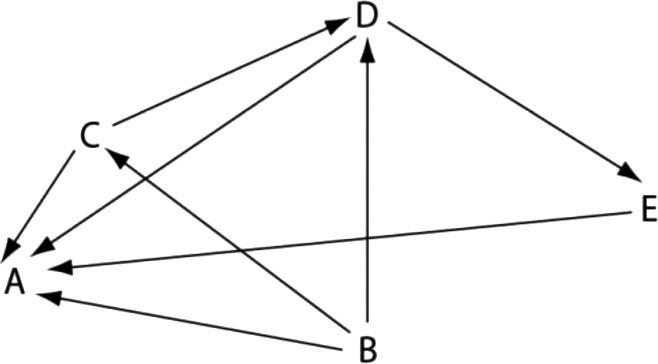
Examine the diagram of a hypothetical food web in Figure 41.3. The arrows represent the transfer of energy between the various trophic levels. Which letter represents an organism that could be a primary producer?
- A) A
- B) B
- C) C
- D) D
- E) E
B
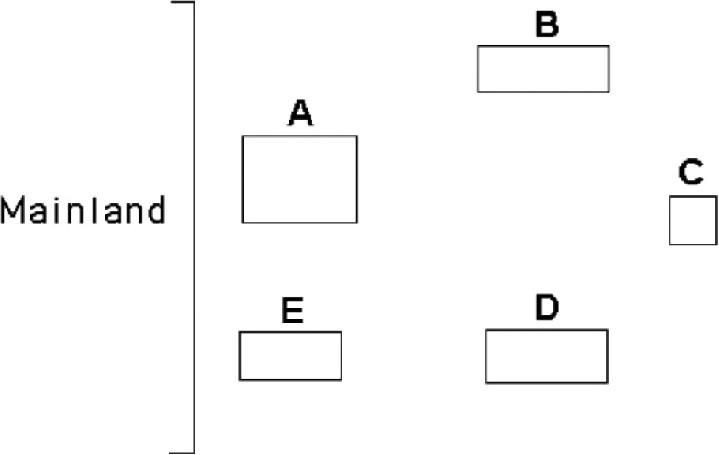
Which island would likely have the greatest species diversity?
- A) A
- B) B
- C) C
- D) D
- E) E
A
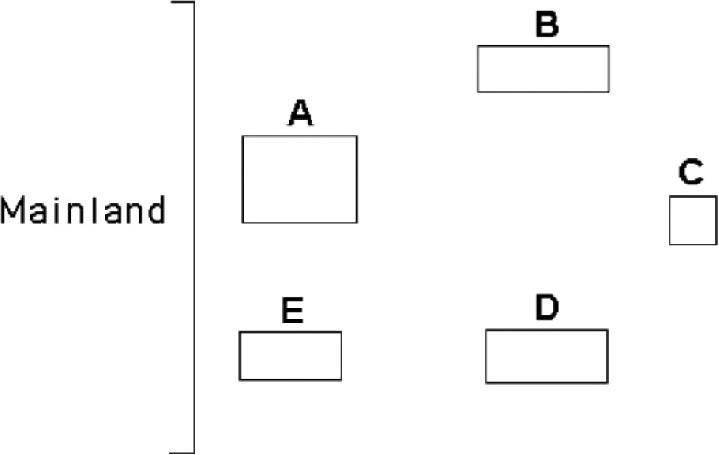
Which island would likely exhibit the most impoverished species diversity?
- A) A
- B) B
- C) C
- D) D
- E) E
C
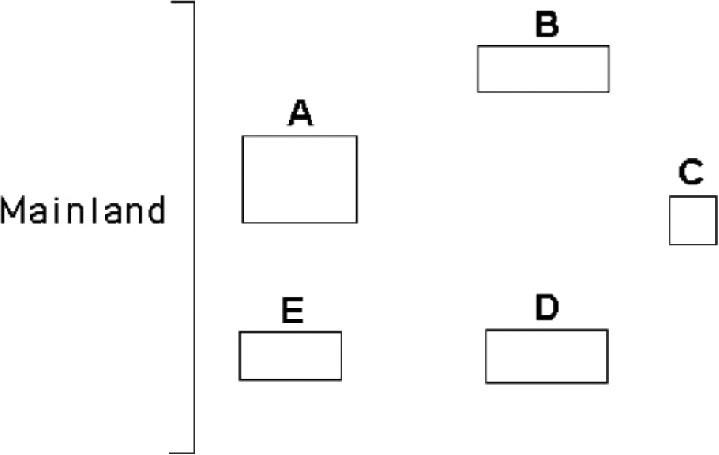
Which island would likely have the lowest extinction rate?
- A) A
- B) B
- C) C
- D) D
- E) E
A
The symbols +, -, and 0 are to be used to show the results of interactions between individuals and groups of individuals in the examples that follow. The symbol + denotes a positive interaction, - denotes a negative interaction, and 0 denotes an interaction that has no effect on the individuals involved. The first symbol refers to the first organism mentioned.
What interactions exist between the cattle egret and grazing cattle?
- A) 0/-
- B) +/0
- C) +/-
- D) 0/0
- E) -/-
B
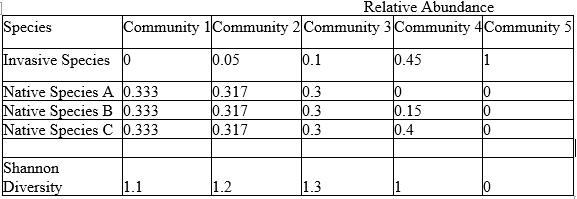
The biological hypothesis for your experiment is based on the model of island biogeography. What is the independent variable of your experiment?
- A) the plant communities
- B) the source patch of the invasive species
- C) the distance from the source patch of invasive species
- D) the relative abundance of the plant species
- E) the length of time from the start to the end of the experiment
C
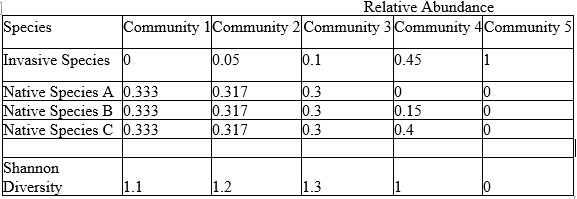
Your research assistant forgets to label the distance at which each community was located. While you wait for your assistant to go back and check on the correct labels, you attempt to match the communities to their distances based on the results. Predict the order of the communities from closest to farthest from the source patch of invasive species.
- A) 5, 4, 3, 2, 1
- B) 5, 4, 1, 3, 2
- C) 3, 2, 1, 4, 5
- D) 1, 2, 3, 4, 5
- E) 5, 1, 4, 2, 3
A
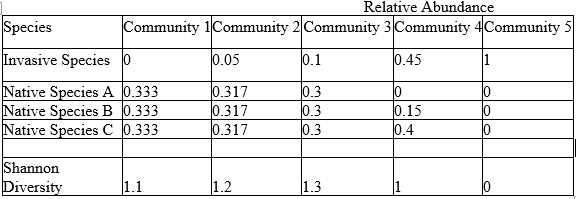
How would you calculate the final Shannon diversity index for each community?
- A) H = −(pinvasive+ pA+ pB + pC)
- B) H = −(pinvasiveln pinvasive+ pA ln pA + pB ln pB + pC ln pC)
- C) H = ln pinvasive+ ln pA+ ln pB + ln pC
- D) H = pinvasiveln pinvasive+ pA ln pA + pB ln pB + pC ln pC
A
Based on the intermediate disturbance hypothesis, a community's species diversity is increased by
- A) frequent massive disturbance.
- B) stable conditions with no disturbance.
- C) moderate levels of disturbance.
- D) human intervention to eliminate disturbance.
C
Which of the following could qualify as a top-down control on a grassland community?
- A) limitation of plant biomass by rainfall amount
- B) influence of temperature on competition among plants
- C) influence of soil nutrients on the abundance of grasses versus wildflowers
- D) effect of grazing intensity by bison on plant species diversity
D
What interactions exist between a lion pride and a hyena pack if they utilize the same food sources?
- A) +/+
- B) +/0
- C) +/-
- D) 0/0
- E) -/-
E
What interactions exist between a bee and a flower?
- A) +/+
- B) +/0
- C) +/-
- D) 0/0
- E) -/-
A
What interactions exist between a tick on a dog and the dog?
- A) +/+
- B) +/0
- C) +/-
- D) 0/0
- E) -/-
C
What interactions exist between cellulose-digesting organisms in the gut of a termite and the termite?
- A) +/+
- B) +/0
- C) +/-
- D) 0/0
- E) -/-
A
What interactions exist between mycorrhizae and evergreen tree roots?
- A) +/+
- B) +/0
- C) +/-
- D) 0/0
- E) -/-
A
The feeding relationships among the species in a community determine the community's
- A) secondary succession.
- B) ecological niche.
- C) species richness.
- D) trophic structure.
D